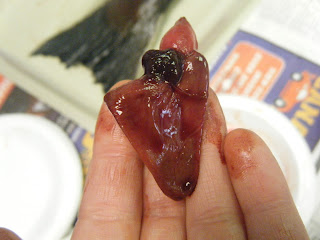Back in April, Division 2 had a special visitor! Kevin came to our classroom to teach us about how a salmon survives in the river. He brought an adult salmon with him, and then he dissected it so we could see all the different body parts that help a salmon stay alive.
 |
| This is an adult male salmon. Can you see its hook nose? |
First Kevin showed us how to tell if an adult salmon is a male or female. This adult salmon is a male. You can tell because its sides are dark red and it has a hooked nose. Male and female salmon are different on the inside, too. A male salmon has two milt sacs and a female salmon will have hundreds of eggs! We saw male and female salmon just like this one, that were ready to spawn, when we visited Adam's River salmon run this September.
The outside of a salmon's body helps it survive in the water. It has sticky slime all over its body to help it swim fast and slip away from predators. Do you know what animals prey on salmon? Salmon's body's are also covered in scales. Kevin showed us that a fish's scales are like a tree trunk - they have growth rings! You can look at the number of rings on a salmon's scales to tell how old a salmon is. We got to look at the salmon's scales through magnifying glasses. What other tool could you use to see a fish scale up close?
 |
| Kevin removes the milt sacs from the salmon. |
Kevin showed us all the different organs you can find inside an adult salmon's body. !He told us how each one has its own job to do in order to keep the salmon alive. We got to take a close look at each organ. It got a little bloody ... but we didn't mind!


At the end of the dissection, we got a special demonstration from Kevin. He showed us how to fillet the salmon and slice it into pieces for drying. In Lytton, many people air dry the salmon with a little bit of salt to make stwen. We talked about all the different ways to cure a salmon, and discovered that some of our families can salmon, air dry salmon, and smoke salmon. Mmm! Have you ever filleted a salmon before?
 |
| Kevin shows us how to slice the fillet to make stwen. |
Can you guess what these different organs are? Leave your answers as a comment below!
Organ #1
Clue: This organ digests the food that the salmon eats.
Organ #2
Clue: Without this organ, a salmon would sink.
Organ #3
Clue: This organ helps a fish collect something very valuable from the water - oxygen!
Organ #4
Clue: This organ is actually a pump made of strong muscle.
Like a house with different rooms, ours has four rooms, but a salmon's only has 2!
Organ #5
Clue: This organ has a twin, but they can both move on their own
to help a salmon see above and below itself at the same time!

































